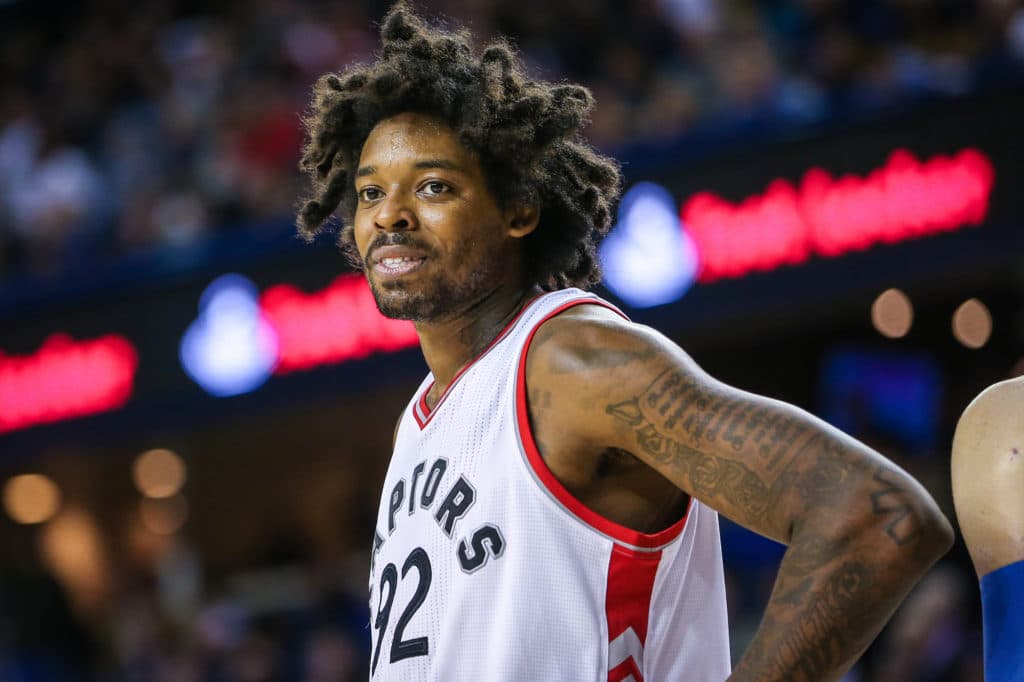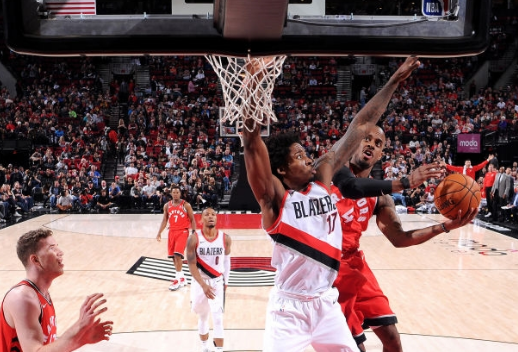You can keep up with all of our player previews here.
With a litany of young guys in the fold, it’s easy for Bebe Nogueira to get lost in the shuffle. He’s been on the roster for a few seasons and the results are mostly bland with moments of excitement. Bebe averaged 19 minutes per game last season but those minutes faded as the campaign wore on. This is the final year of the 24-year-old’s contract, putting a pressure on the seven-foot Brazilian that hasn’t really been there in his career.
In 2016-17, Bebe was asked to do more. Bismack Biyombo went to Orlando for that sweet, sweet cash, and Jakob Poeltl was too green for serious back-up centre minutes at the start of the season. It didn’t really work out. Bebe was asked to defend and rebound, standard fare for the role. He struggled in rotations and pick and roll defence because of his below-average mobility. And despite the height and length, Bebe posted a 12.6% total rebound percentage. In isolation, it’s an okay mark, not terrible but not really a strength either. But factor in that he was playing the majority of his minutes with Patrick Patterson, who isn’t a great rebounder either. That’s a problem. Toronto addressed the problem by trading for Serge Ibaka and P.J. Tucker to give them some line-up flexibility, and Jakob Poeltl got some more run.
FURTHER READING: Lucas Nogueira is good, so where does he fit?
Bebe’s future is a bit bleak. Toronto has Poeltl, who is young, showing signs of being a good bench player at the least and under contract for a while at a low figure. It’s also tough to create the narrative of why Nogueira makes a jump this year. What significant change has he made that would power him to relevance in this roster? It’s hard to find, but I’m not sure he needs to make a significant change to be a useful player as long as he’s got that length.
What won’t change with Bebe is the physical tools. On a recent podcast, ESPN’s Zach Lowe talked about how NBA front office people mentioned the impact length has on the game but that analytics haven’t been able to totally quantify yet. (You could argue that there are stats that provide some direction like looking at the change in average shot attempt distance when a player is on/off the court or defensive rating when they’re on the court, but those are really noisy stats.)
Lowe said that length can deter offensive players from doing something they normally do, forcing players to settle. The best example I have of this is the 2016 playoff series between Toronto and Miami. Hassan Whiteside absolutely scared off DeMar DeRozan and Kyle Lowry from driving to the rim.
Whiteside is much more athletic than Nogueira, but there’s a chance Bebe could be a percentage of that in limited minutes. He’s got that 7-6 wingspan and if he just drops in pick and roll coverage, players will think twice when driving. In 2016-17, Bebe had a 7.1 block percentage, a top-ten mark in the league. With the NBA moving towards more and more threes, I could see offences taking advantage of bigs that drop back by taking more off-the-dribble threes that were typically reserved for only gunslingers or the best three-point shooters. Bebe’s advantage is neutralized if this happens.
And I said that what won’t change with Bebe is the physical tools, but it’s a bit of a paradox. Those tools were there last year, and he really didn’t see meaningful minutes past the All-Star Break.
On the other end of the court, Bebe’s a bit more useful. He’s shown decent vision and passing skills, and if the preseason offence carries into regular season, Raptor bigs will be called upon to past out of the post here and there. That’s a sneaky-useful skill, but I’m not sure it moves the needle a ton.
Again, it’s the physical tools that are more important. Nogueira and Lowry have shown good chemistry in the pick and roll because Lowry can float passes where only Bebe can get them. That kind of vertical threat is important for a team that is looking to shoot more corner threes: if Bebe rolls hard to the rim, the weakside defender needs to bump the roller even earlier to make the catch difficult and further from the rim. But even if Bebe’s catch is too far from the rim, that’s where his passing skills come in. He can find the open guy for an open shot. That’s a good formula for a bench offence.
But Bebe has a Poeltl problem: Jak and Delon Wright have shown a good chemistry in preseason, and Poeltl’s got great hands and finishing ability.
In preseason, Casey has given both bigs looks as the back-up five. Poeltl is winning that battle, putting distance between the two in a stellar game against Detroit.
Sure, there’s still an opportunity for Bebe to make up ground against Poeltl against Chicago. But I think his reputation is cemented for this coaching staff: they’ve had him for three years, and there’s very little incentive to give Bebe minutes when his contract is up and Poeltl stands to benefit from the experience.
Here’s the realistic outlook: at best, Bebe flourishes into a lengthy big whose can handle speedy bench scorers looking to attack the rim and cause stress on an opposing defence. I can totally picture #ContractYearBebe being a thing, and I’m honestly rooting for it. At worst, he doesn’t play a ton of meaningful minutes but provides some depth at the position. For Toronto, this is a pretty good situation. Unfortunately for Bebe, that worst-case scenario is a grim one, and looks more likely than not.




